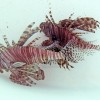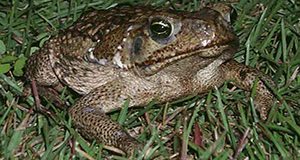Global trade and travel transport plants and animals from native ranges to new ecosystems. About 10 to 20% of nonnative (exotic, alien) species that arrive in new locales become invasive, meaning they are likely to harm the environment, economy, or public health. Preventing the introduction of invasive species is the most effective way to protect native biodiversity and ecosystem integrity. Once an invader begins to establish and spread, its control costs increase rapidly. Florida ports are the entry points for about half of the reptiles, arachnids, insects, and crustaceans imported into the United States. These arrivals, coupled with hospitable climate and habitats, have made Florida home to more invasive species than any other state but Hawaii. While it is too late to prevent the invasion of Burmese pythons and Argentine black and white tegus, we can act to prevent other potentially destructive species from establishing. This 6-page fact sheet written by Venetia Briggs-Gonzalez, Kyle Allen, Rebecca G. Harvey, and Frank J. Mazzotti and published by the Department of Wildlife Ecology and Conservation explains how to assess the risk that a given invasive species presents to the environment and how to develop and use risk-screening tools to reduce the harmful effects of invasions or, better yet, prevent them entirely.
http://edis.ifas.ufl.edu/uw419
Tag: Invasive Animals
Invasive Species of Florida’s Coastal Waters: The Red Lionfish (Pterois volitans) and Devil Firefish (P. miles)
 Two species of Indo-Pacific lionfish (Pterois volitans and P. miles) are the first reported non-native marine fish to become established in the Atlantic Ocean. Genetic studies indicate that lionfish in the Atlantic are likely all descendants of a few individuals, consistent with the widely held belief that lionfish were introduced into the Atlantic as a result of accidental or deliberate release of aquarium pets. Regardless of the method of introduction, the prolific spread of these invasive species in the Atlantic Ocean ecosystem is cause for concern. This 5-page fact sheet was written by Maia McGuire and Jeffrey HIll, and published by the UF Department of Sea Grant, January 2013.
Two species of Indo-Pacific lionfish (Pterois volitans and P. miles) are the first reported non-native marine fish to become established in the Atlantic Ocean. Genetic studies indicate that lionfish in the Atlantic are likely all descendants of a few individuals, consistent with the widely held belief that lionfish were introduced into the Atlantic as a result of accidental or deliberate release of aquarium pets. Regardless of the method of introduction, the prolific spread of these invasive species in the Atlantic Ocean ecosystem is cause for concern. This 5-page fact sheet was written by Maia McGuire and Jeffrey HIll, and published by the UF Department of Sea Grant, January 2013.
http://edis.ifas.ufl.edu/sg132
Options for Unwanted Exotic Pets (WEC308/UW353)
Exotic reptiles, birds, and fish are popular pets. However, many species grow large and require special cages or become difficult to handle. If at some point you are no longer able to care for your exotic pet, you have several options that are discussed in this brochure, written by Steve A. Johnson, Monica E. McGarrity, and Dustin Smith, and published by the UF Department of Wildlife Ecology and Conservation, March 2011.
http://edis.ifas.ufl.edu/uw353
WEC291/UW336 Nonnative Reptiles in South Florida: Identification Guide
WEC291, a 3-page illustrated fact sheet by Laura M. Early, Christy A. Harry, Rebecca G. Harvey, and Frank J. Mazzotti, provides color-coded visual reference and details for identification of non-native lizards and snakes and their native look-alikes. Published by the UF Department of Wildlife Ecology and Conservation, August 2010.
http://edis.ifas.ufl.edu/uw336
WEC218/UW259: The Cuban Treefrog (Osteopilus septentrionalis) in Florida
Revised! WEC218, an 8-page fact sheet by Steve A. Johnson, describes this member of the frog family Hylidae which is invasive to Florida, how to identify it, its ecology and natural history, its impact in Florida, and what homeowners can do to manage Cuban treefrogs around their home. Includes additional resources. Published by the UF Department of Wildlife Ecology and Conservation, August 2010.
http://edis.ifas.ufl.edu/uw259
WEC292/UW337 Introduced Reptile Early Detection and Documentation Training: Instructor Guide
WEC292, a 5-page illustrated fact sheet by Steve Johnson and Monica McGarrity, familiarizes trainers with the REDDy program and provides the resources necessary for presenting the course concept and basic instructions to potential trainees and answering their questions. Published by the UF Department of Wildlife Ecology and Conservation, August 2010.
http://edis.ifas.ufl.edu/uw337
SGEF175/SG094 Invasive Species of Florida’s Coastal Waters: The Asian Green Mussel (Perna viridis)
SGEF-175, a 5-page illustrated fact sheet by Maia McGuire and John Stevely, describes this non-native marine animal that has been found in numerous locations in Florida, Georgia and South Carolina — distribution, biology, habitat, impacts, and what people can do. Published by the Florida Sea Grant Program, August 2009.
http://edis.ifas.ufl.edu/SG094
WEC242span/UW288 Pitones Birmanas en Florida del Sur: Soporte Científico para el Manejo de Especies Invasoras
WEC-242-Span, a 10-page illustrated fact sheet by Rebecca G. Harvey, Matthew L. Brien, Michael S. Cherkiss, Michael Dorcas, Mike Rochford, Ray W. Snow, and Frank J. Mazzotti and translated by Marianna Domínguez, is the Spanish language version of WEC-242, Burmese Pythons in South Florida: Scientific Support for Invasive Species Management. It describes the population of Burmese pythons in south Florida, python reproduction, size and appearance, and the work of the Python Science Support Team. Includes information about how Florida residents can help prevent the spread of invasive snakes, and references. Published by the UF Department of Wildlife Ecology and Conservation, May 2008.
http://edis.ifas.ufl.edu/UW288
